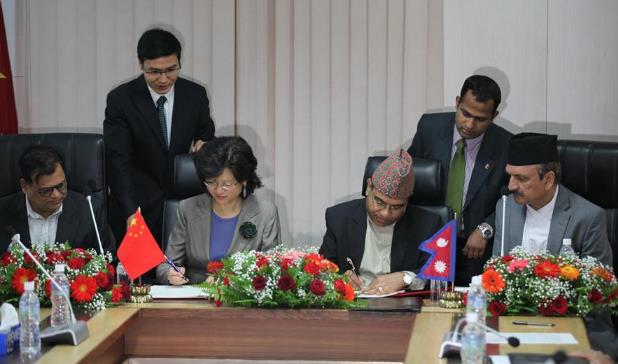 KATHMANDU, May 27 (Xinhua) — Nepal’s efforts to enhance connectivity and cooperation with China in recent years have been reaping benefits for the Himalayan country in various areas of economy including tourism and aviation.
KATHMANDU, May 27 (Xinhua) — Nepal’s efforts to enhance connectivity and cooperation with China in recent years have been reaping benefits for the Himalayan country in various areas of economy including tourism and aviation.
The Memorandum of Understanding on the framework agreement on China’s Belt and Road Initiative signed by Nepal on Friday is expected to boost the cooperation between the two countries.
Nepal’s policy makers, experts and private sector have said that Nepal’s entry into One Belt One Road initiative will pave the way for increased investment in connectivity projects which in turn will help Nepal attract global investment.
Nepal has already reaping benefits from increasing connectivity with China in some of the areas. One of the areas is the aviation sector.
Nepal’s national flag carrier, Nepal Airlines Corporation (NAC), has now been operating with majority China-made planes for domestic flights.
It got the Chinese planes at much lower prices than the peer aircrafts from other companies. “The cost of purchasing Xian MA60 is almost half of the cost the peer aircraft such as ATR,” said Poshak Gyawali, director at the engineering department of NAC, told Xinhua on Thursday.
“The price of Harbin Y12e is also lower compared to similar planes in the market.”
The delivery of Chinese planes has been seen as a major step to improve mountainous Nepal’s domestic transport network.
The cooperation in aviation sector is not limited in purchasing China-made aircraft. China has also agreed to build a modern hanger for the NAC’s planes at Tribhuvan International Airport in Kathmandu. “It is now in the process of detailed design,” said Gyawali.
With China’s financial assistance, an international airport is also being built in Nepal’s western city Pokhara, one of the key tourism hotspots.
The Two countries signed a loan agreement worth 215.96 million U.S. dollars in Beijing during former Nepalese Prime Minister KP Sharma Oli’s visit in March 2016.
“It took some time for procedural works to release the loan. The loan will be released shortly,” said Yug Raj Pandey, under-secretary at the Ministry of Finance who oversees economic cooperation with China, told Xinhua on Thursday.
Once the loan is released, China CAMC Engineering Corporation, which has already got the contract, is expected to start the construction work. The construction of the project is expected to ease heavy traffic at the TIA and boost Nepal’s international connectivity.
Beside airport development, air connectivity between the two countries has started to contribute to the rise in Chinese tourist arrivals in Nepal.
Currently, four Chinese airlines –Air China, China Southern, China Eastern and Sichuan Airlines — have established links between Nepal and various cities of China.
The NAC which does not have any direct flight with the Chinese mainland is also preparing to start flight to Chinese city Guangzhou. When China designated Nepal as outbound destination for Chinese visitors in 2001, there were a very limited number of Chinese visitors in Nepal.
China has become second largest source market for Nepal’s tourism sector after India, which is traditionally the largest source market since 2010. Nepal received a total of 104,005 Chinese tourists in 2016 as arrivals from China surged by 55.26 percent.
While enhanced air connectivity with China contributed to rise in the number of Chinese visitors in Nepal, Nepalese tourism entrepreneurs believe that enhanced connectivity by land with China would help attract more Chinese tourists to Nepal.
“Particularly cross-border railway connectivity will be very important to attract Chinese tourists in mass scale,” Kishore Raj Pandey, chairman of Sathi Travel, the first Nepalese travel agency to bring Chinese tourists to Nepal, told Xinhua on Thursday.
“Cross-border railway connectivity will encourage many Chinese tourists visiting the Tibet Autonomous region of China to visit Nepal”
While China is expected to expand its railway network to bordering Geelong port within the next few years, Nepal has also planned to develop a railway from capital Kathmandu to Rasuwgadhi, a border town across Geelong port.
In line with the agreement signed in China during former Nepalese Prime Minister Oli’s visit to China in March 2016, a couple of Chinese companies have shown interest in developing cross-border railway networks on the Nepali territory connecting Kathmandu to Rasuwagadhi, according to Nepal’s Department of Railway.
The railway connectivity with China is expected to help Nepal become a bridge between China and the South Asia under the Belt and Road initiative.
As the main focus of the Belt and Road Initiative is enhancing connectivity with neighbouring countries and beyond, Nepal will also be part of the global transport network.
“This will help Nepal promote trade, investment and tourism along the network,” Posh Raj Pandey, an economist, told Xinhua.

